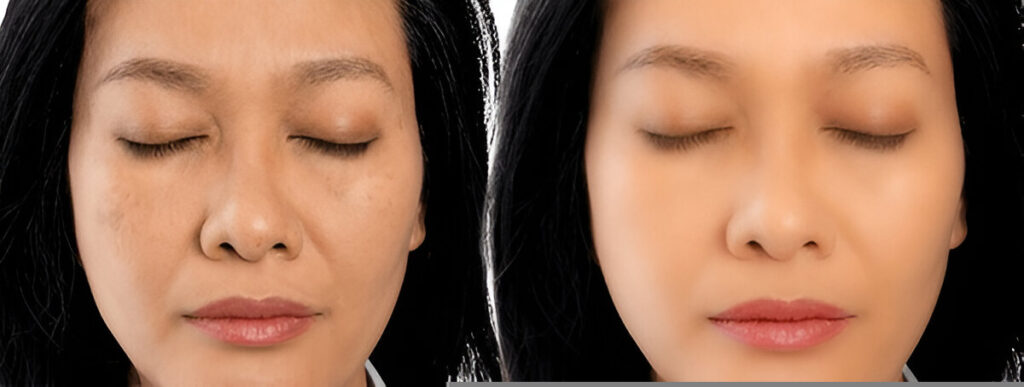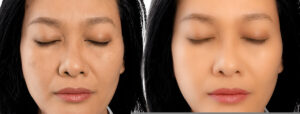Melasma Treatment Singapore: Which Fruit Should you Eat?

Melasma is a skin condition that causes dark, discolored patches, typically on the face. These patches can appear on the cheeks, forehead, upper lip, the chin, and even the back among other locations.
For many people, melasma can be a source of frustration due to its persistent nature and impact on appearance. Essentially, this is why many people seek specialized treatments to reduce melasma despite the fact that the condition itself doesn’t pose any serious risk to their general health.
One of the most interesting about melasma treatment is that even your diet influences its management melasma. This is because certain fruits are known to support skin health and reduce hyperpigmentation.
So, Which Fruit Is Good for Melasma?
To begin with, a well-balanced diet, that is rich in antioxidants and vitamins, can help improve skin health and reduce melasma. There are several fruits which are incredibly rich in properties that may assist in skin repair and pigmentation reduction thus the question; which fruit is good for melasma? Here are some of the best fruits you can eat to support your melasma treatment in Singapore:
- Papaya: Papaya is packed with vitamin C and papain, an enzyme that promotes skin exfoliation. It helps remove dead skin cells and encourages new cell growth. This can lead to a brighter and more even skin tone. Importantly, papaya contains antioxidants that protect against oxidative stress, which can worsen melasma. Regular consumption of papaya, whether eaten raw or blended into a smoothie, can support skin renewal.
- Pomegranate: Let’s put it like this; this fruit is a powerhouse of antioxidants. It is particularly rich in ellagic acid, which is known to help reduce hyperpigmentation. Pomegranates also support blood circulation and collagen production, both of which are essential for maintaining healthy skin. Drinking pomegranate juice or adding the seeds to your diet can improve skin tone and slow down pigmentation caused by melasma.
- Tomatoes: Rich in lycopene which is a powerful antioxidant, tomatoes can also help protect the skin from sun damage. Incidentally, that is one of the leading causes of melasma. Lycopene acts as a natural sunscreen from within. This way, it helps reduce the effects of UV exposure. Consuming raw tomatoes or tomato juice regularly can support your skin health and minimize pigmentation over time.
- Lemon: Lemon made it to this list, thanks to its high vitamin C content. It is often used to lighten dark spots and it is easy to see why. The citric acid in lemon juice gently exfoliates the skin to remove dead cells and reduce the intensity of pigmentation. Drinking lemon water daily can provide internal skin benefits. However, you will want to use it cautiously on the skin due to its acidity.
- Berries (Blueberries, Strawberries, and Raspberries): These fruits may be small but they come packed with antioxidants, particularly anthocyanins and vitamin C, which help repair damaged skin and reduce oxidative stress. Berries also support collagen production which helps keep the skin firm and youthful. Adding a variety of berries in your diet can increase your skin’s ability to heal from melasma.
What Is the Best Professional Treatment for Melasma?
While dietary changes and topical creams can help lighten melasma, you can’t rely on them alone if you’re keen on substantial improvements. Here’s where professional melasma treatment in Singapore comes in.
These treatments offer more effective and long-lasting results. The best approach depends on the severity of the pigmentation and your individual skin type. Real quick, here are some options you may be recommended;
- Chemical Peels
Chemical peels use acids such as glycolic acid or trichloroacetic acid to exfoliate the top layer of skin. It is this exfoliation action that helps reduce pigmentation.
By removing damaged skin cells, chemical peels encourage the growth of new, evenly toned skin. Multiple sessions may be needed for significant improvement, and sun protection is essential after treatment to prevent recurrence.
· Laser Therapy
Laser treatments target excess melanin in the skin to break it down and allow the body to naturally remove the pigmented cells. There are advanced laser technologies like the Q-switched laser for example, that offers controlled energy delivery to minimize damage to surrounding tissues.
However, laser treatment should only be performed by experienced professionals. The reason for this is that incorrect use can worsen pigmentation or even cause unintended complications or injury.
· Microneedling with Tranexamic Acid
Just as it sounds, microneedling involves the use of tiny needles to create micro-injuries in the skin. This action helps stimulate collagen production and enhance the absorption of topical treatments.
When combined with tranexamic acid, which inhibits melanin production, microneedling can effectively reduce melasma over time. This treatment is often recommended for those who have not responded well to other methods.
· Prescription Topical Creams
Your dermatologist or aesthetic doctor may also prescribe creams which are formulated with hydroquinone, tretinoin, or kojic acid to lighten melasma. These ingredients work by inhibiting melanin production and promoting skin renewal.
Prescription treatments are generally stronger than over-the-counter options. Because of this, they too require medical supervision to prevent skin irritation among other potential complications.
When to Go to the Doctor for Melasma Treatment?
Melasma can be effectively managed with skincare and lifestyle changes. However, there are certain situations where you may want to go to the doctor for specialized treatments like the ones discussed above. Here are some of the most notable instances:
- Melasma Is Worsening Despite Home Treatments: If your melasma continues to darken or spread despite using sunscreen, skincare products, and a healthy diet, it may indicate that professional care is needed. Some cases of melasma are resistant to topical treatments and require medical-grade procedures.
- New or Unusual Skin Changes Appear: If you notice changes in the texture or shape of the pigmented areas, please have them examined by a dermatologist. While melasma is generally harmless, other pigmentation disorders like melanoma or post-inflammatory hyperpigmentation, can sometimes be mistaken for melasma. With professional diagnosis, you can rest assured that you’re targeting the right conditions with your treatment.
- Melasma Is Impacting Self-Confidence: For many people who visit our clinic for melasma treatment in Singapore, the psychological impact of melasma can be significant. If pigmentation is affecting your confidence and quality of life, seeking professional treatment can help restore an even complexion and improve self-esteem. Your skin or aesthetic doctor can recommend personalized treatment plans based on your skin type and lifestyle.
Wrapping Up
While there is no specific cure for melasma still, its appearance on the skin can be reduced significantly. There are not only foods that can help but also professional treatments that can significantly improve your condition.
So, do not suffer in silence if your melasma isn’t responding to the remedies you’ve tried or affecting your confidence. Seek medical advice to see what works for your situation. If you’re in Singapore, get in touch with us below to schedule a consultation;
Edwin Lim Medical Aesthetic Clinic – Dr Edwin Lim
#02-12/13, Changi City Point
5 Changi Business Park Central 1,
Singapore 486038
By appointment only:
#05-51, Lucky Plaza
304 Orchard Road
Singapore 238863
+65 690042218 +65 96372218 (WhatsApp)




